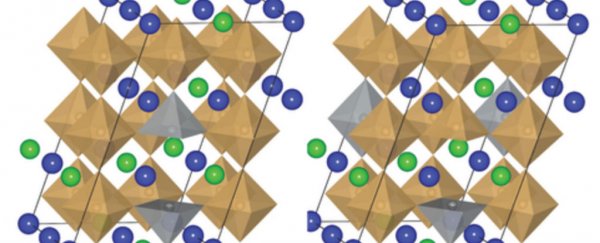Scientists have discovered that a certain type of mineral has the right properties to extract energy from multiple sources at the same time - turning solar, heat, and kinetic energy into electricity.
The mineral is a type of perovskite - a family of minerals with a specific crystal structure - and this is the first time researchers have identified one that can convert energy from all three sources at room temperature.
Since the first perovskite solar cell was invented back in 2009, these minerals have been positioned as the 'next big thing' in renewable energy technology.
Perovskite solar cells have proven to be cheaper and more efficient than traditional silicon solar cells, and their efficiency levels have increased from 3.8 percent in 2009 to 22.1 percent in 2016, making them the fastest-advancing solar technology to date.
But solar energy has one big problem: what happens when there isn't a lot of sunlight - or none at all, in the case of devices that are used mainly indoors?
A team from the University of Oulu in Finland has been messing around with different types of perovskite minerals to see if any of them could harness energy from multiple sources, and they've identified the perfect candidate - KBNNO (or Ba, Ni co-modified KNbO3 nanocrystals).
While the mineral will never be efficient enough to power something as large your home the way perovskite solar cells could, the researchers say it could be used in electronic devices like phones and laptops, and the various 'smart' gadgets that will soon be filling our homes and city streets.
"This will push the development of the Internet of Things and smart cities, where power-consuming sensors and devices can be energy sustainable," says one of the team, Yang Bai.
Like all perovskites, KBNNO is a ferroelectric material, which means it's filled with tiny electric dipoles that work kind of like tiny compass needles.
When a compass is exposed to a magnet, the needles move in a certain direction. Similarly, when ferroelectric materials experience changes in temperature, their dipoles misalign, and this triggers an electric current. This property is known as pyroelectricity.
KBNNO is also photovoltaic, which means it can generate an electric current when exposed to sunlight, and is piezoelectric, which means it can convert changes in pressure caused by motion into electricity.
Researchers in the past have identified KBNNO's photovoltaic capabilities, and have even seen hints of its other properties, but only at extremely low, impractical temperatures - a couple of hundred degrees Celsius below freezing, the University of Oulu team points out.
When they tested its properties at room temperature, they found that, while it was outclassed by other perovskites when it came to generating electricity from single sources of energy, the fact that it could generate electricity from three different sources at once could make it even more valuable in certain situations.
The researchers also report that they've found a way to modify the composition of KBNNO to improve its heat- and pressure-sensitive properties, so they predict its efficiency levels will increase with further tweaks.
"It is possible that all these properties can be tuned to a maximum point," says Bai.
Different types of so-called hybrid energy harvesters have been developed in the past, but the researchers say what makes this mineral special is that all three properties are right there in the crystal structure - you don't need to keep adding layers of different materials to capture multiple sources of energy.
As the team reports in their paper:
"[Hybrid energy harvesters] usually utilise different materials for different harvesting principles or energy sources. In such cases, for a defined space, one has to compromise either on the number of harvested energy sources or on the space taken by different energy harvesting components. …
This type of perovskite ferroelectric solid-solution could show a strong piezoelectric and/or pyroelectric response, together with a considerable photovoltaic effect, thus providing a unique opportunity to develop a novel multi-source energy harvester or multi-functional sensor based on a single material."
As is often the case with these kinds of discoveries, it will be a long time before the mineral is developed for market use, but the research does show that we're still not even close to knowing all there is to know about Earth's mineral properties.
If one of them can free us from the tyranny of charging cords, we would be so happy.
The study has been published in Applied Physics Letters.
